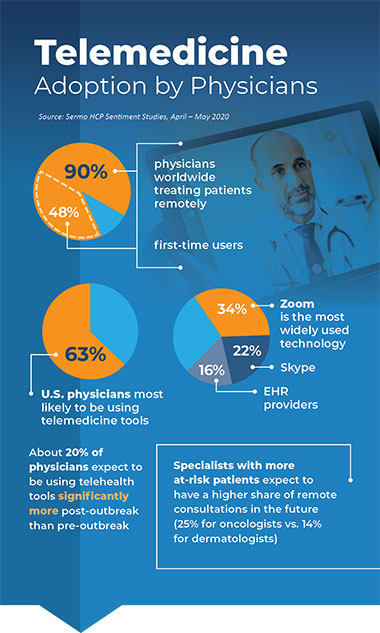By Deborah Borfitz
June 30, 2020 | The shift from face-to-face patient visits to remote medical appointments is a worldwide phenomenon, but most especially in the U.S., finds a recent global survey conducted by the doctors-only social networking platform Sermo. Unsurprisingly, Zoom tops the list of most-mentioned technologies. About one-fifth of surveyed doctors say they expect to be using telehealth tools “significantly” more post-pandemic than before COVID-19 upended business as usual.
The list of available telemedicine software solutions is lengthy. One of the most widely used technologies among physician practices is healow Telehealth Solutions, a HIPAA-compliant option offered by eClinicalWorks that can work alongside any electronic health record (EHR). The company’s website is brimming with testimonials and stats on escalating utilization since early March. More than 50,000 doctors were using the platform at last count.
As shared by a spokesperson for eClinicalWorks, patients are encouraged to fill out questionnaires prior to their telehealth appointment to make virtual visits more productive. If they have any personal wearable devices (e.g., glucometer, weighing scale or blood pressure cuffs), they can also enter their vitals using the healow app.
 But EHRs on the whole constitute only 16% of the telemedicine technologies currently being used by doctors, as estimated by the Sermo survey.
But EHRs on the whole constitute only 16% of the telemedicine technologies currently being used by doctors, as estimated by the Sermo survey.
Software Freebies
Neil Baum, M.D., medical advisor for Vanguard Communications and professor of clinical urology at Tulane Medical School, says telemedicine is a “great opportunity” for physician practices to engage patients in a new way. “We’re still able to practice good medicine without having to be face to face or touching a patient.”
Virtual visits don’t necessarily require special software or extra expense, says Baum. Vanguard Communications breaks down the no-cost, easy-to-use apps approved for telemedicine during COVID-19 as follows:
-
Apple FaceTime, best for iPhone users, but requires phone number disclosure
-
Facebook Messenger, best for ubiquity and possible to remain private, but less trustworthy
-
Signal, best for trust but requires phone number disclosure
-
Microsoft Teams (formerly Skype for Business), best for Microsoft users, possible to remain private and trustworthy
-
Google Meet (formerly Hangouts Meet), best for G-Suite users, also possible to remain private and trustworthy
The consultancy recommends Google Meet and Microsoft Teams, both of which offer the option of a business association agreement—a partnership which, under HIPAA, allows access to protected health information.
Baum stresses the importance of documenting virtual visits and video conversations just as physicians would an in-office appointment. “If you didn’t document, then you didn’t do it, and then you don’t get paid for it,” he says.
App Uptake
“There is a very high likelihood that doctors will use apps like FaceTime and Skype,” says Jonathan Stanley, technology director at Vanguard Communications. “Stay-at-home orders have caused a tremendous impediment to non-emergency healthcare. In order to provide care during this time, providers and patients are using the tools they are familiar with to enable frictionless adoption.”
Google Trends indicates interest in telehealth wildly peaked in mid-March, and in early April Walgreens added a service to help patients find doctors who offer telehealth services to treat over 100 conditions, Stanley notes.
But older doctors are unlikely to embrace the apps, says Baum. He further cautions that many of them are neither HIPAA-compliant nor encrypted. The waiving of existing regulatory restrictions is the primary driving force behind the fast pace of telehealth adoption.
The advantage of simple video chats is that highly specialized and complicated equipment are not required, says Stanley. Video chats are suitable for prevention, monitoring, and wellness—e.g., genetic counseling for infertility, monitoring ongoing high blood pressure and counseling for depression.
“Practices need not find the 'perfect' solution immediately,” Stanley says. “Rather, providers may test multiple systems to determine the best fit for their patients and staff.”
E-consults
While the cost-effectiveness of telemedicine remains a subject of debate, and an investment in broadband will be needed to ensure equitable access, research has shown that patients like the convenience of receiving care virtually.
There is also now evidence that electronic consultations between providers is an appropriate and useful alternative to in-person visits, as demonstrated by a multi-institutional team of researchers who recently published their novel metrics in the Annals of Internal Medicine (DOI: 10.7326/M19-3852). Their analysis looked at 6,512 e-consult requests made to five specialties—hematology, infectious disease, dermatology, rheumatology, and psychiatry—between October 2017 and November 2018.
Researchers determined that 70% of the e-consult were appropriate (ranging from 61% in rheumatology to 78% in psychiatry) and 81% were associated with avoided face-to-face visits (ranging from 62% in dermatology to 93% in psychiatry).
Appropriateness of e-consults was gauged by four criteria: not answerable by reviewing evidence-based summary sources, not merely requesting logistic information, having appropriate clinical urgency, and having appropriate patient complexity. Utility was measured by rate of avoided face-to-face visits within 120 days of the e-consult.
The study was conducted inside a single integrated health system where requesting and consulting providers share a common EHR, meaning the findings may not be generalizable to providers outside that environment.